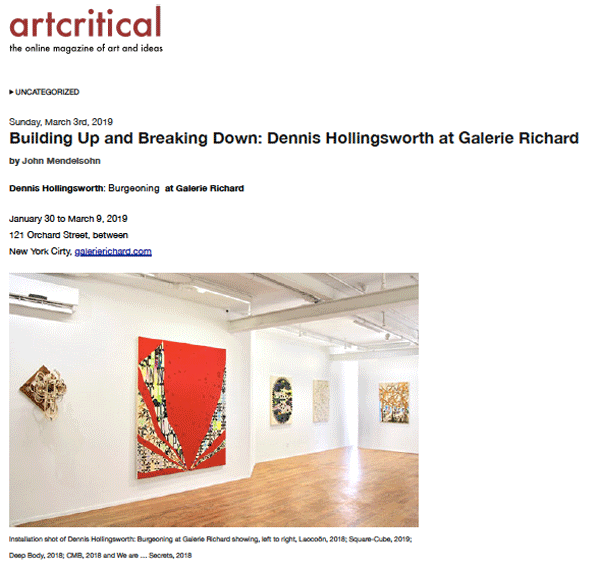February 26, 2019
What are we seeing?

I'm delighted to read John Mendelsohn's review of my show at Galerie Richard in ArtCritical. Precise, distinct and insightful. I'm especially pleased since David Cohen is the publisher and editor of ArtCritical, and the host of Review Panel. I consider Review Panel to be the best venue of live art criticism in New York City, bar none. In these events, one can hear writers think on their feet and the event is quite open with Cohen involving the audience in the give and take of opinion. Close readers of this blog will find many notes that I have taken at Review Panel events over the past several years.
I'm burgeoning... with gratitude.
Building Up and Breaking Down: Dennis Hollingsworth at Galerie RichardPosted by Dennis at February 26, 2019 12:23 PM
by John Mendelsohn"What are we seeing?" That is the fundamental question that always seems to bedevil us when we look at risk-taking art. We are asked not simply to experience a work but to intuit a whole constellation of intentions: aesthetic, ideological, and poetic. In the case of Dennis Hollingsworth, we have our work cut out for us, in spades. That is not to say that the effort to know his work is a slog - far from it. In these paintings are delights and conundrums, both brain-twisting and eye-popping.
There is an antic, psychedelic spirit at work in the eighteen pieces which comprise this exhibition. Hollingsworth arrives at the derangement of the senses via multifarious stimuli - stylized organic ornamentation, phrases spelled out in large letters, intense patterns, and paint, marbleized and in thick, dripping impasto. These and other motifs are layered in compositions that seem joyful and fraught in equal measure.
The works - primarily paintings, along with two wall pieces, and a sculptural vitrine - share a dimensional quality, both in their construction and their surface treatment. This projective thrust is central to Hollingsworth's project, a baroque celebration of painting's capacity to impinge upon our space and our consciousness.
Among the most intriguing of the pieces are the constructed paintings, including So That We Could See (2018), a white convex form, like the sectioned canopy of an umbrella, covered with the words of the title, and thick skeins of paint. The effect is a praise song for vision itself. The same spirit animates Dazzling Treasures (2018), which has ten circular panels, each like a separate screen or a unit of an insect's compound eye, displaying blossoms, webs, drips of paint, and words, including STARS, SUN and WE.
Looking Back to Look Forward (2019), is quite a production, a kind of theater set of paintings within a painting. Easier to apprehend than to describe, this work begins with an abstract shield-like form, in front of which projects an array of ovoids with thick or flowing paint. Ensconced above the main forms is a miniature version of the painting, like the artist's original thought presiding over the completed work. The painting's elements are attached to a wood scaffolding that is curiously neutral and functional in a work whose elements are otherwise so thoroughly active.
Perhaps the best way to read the built support is to see it in terms of the modernist grid that informs many of the works in the exhibitions. The painting's title reminds us that Hollingsworth is scanning the history of the past century's painting, picking up signals from stars, both nearer and more distant: Matisse in the leaf and flower forms, Pollock in the use of paint as its own living corpus, Ryman in the appeal to conceptual rigor, and Lawrence Weiner in the cryptic language.
But beyond any received wisdom, these paintings possess an
essential originality and weirdness, in the best sense. They seem to allude to an intense awareness, where touch and vision are at play together. In Deep Body (2018) the crenelated black oval, filled with shivering lines and dark forms, reads like a tantric embodiment of this state of inner harmony. In this heightened condition, building up and breaking down appear as equally desirable. In We Are... Secrets (2018), a field of red and yellow lines has been eaten away, leaving a star-like neural network, behind which is a band of letters, the partially visible title.The painting Square Cube (2019), is a high-style vamp, with an array of the artist's favored elements of leaves, words, and elongated asterisks mostly covered by engulfing waves of red, studded with extruded paint that resembles spiny sea urchins. This painting, although recent, seems to hark back to some of the earlier works in the exhibition, displayed in the back gallery - such as Minerva's Serpents (2015) and Limitlessness and Strange Desire (2015) - with their extravagant, totalizing approach to a continuous field that is continually being interrupted.
There are two possible hints of the direction that Hollingworth's recent work might open up. The sculptural wall reliefs, Laocoön (2018) and Second Order Revelation (2018), both make manifest the wood support hidden in other works, here functioning like a cross upon which is screwed the living body of looping lines of canvas. A second path is displayed in the painting CMB (2018), which suggests a via negativa, a way of knowing that rejects the material certainty of Hollingsworth's mostly emphatic works. Here we see what seems to be a truncated mandorla, an almond shape that recurs in religious art, composed of wisps and phantom residues of paint on raw canvas, apparently the result of multiple off-printings of an empty sperm-like form. It is as if a tender, existential recognition has unexpectedly made itself known.
Leave a comment